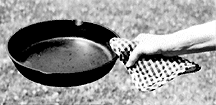developing an intuitive feel for the dynamics of solar cooking
 have you ever wondered why
you yourself didn't come up with the idea of the solar box cooker? why didn't it occur to
you or me naturally that a double-walled, foiled, cardboard box covered with a sheet of glass could
easily reach cooking temperatures? i think i know why.
have you ever wondered why
you yourself didn't come up with the idea of the solar box cooker? why didn't it occur to
you or me naturally that a double-walled, foiled, cardboard box covered with a sheet of glass could
easily reach cooking temperatures? i think i know why.
we don't seem to have an innate grasp of what makes for a good insulating material. i remember that when i bought my brick house in cold seattle, it made sense to me that the bricks would hold in the warmth during the winter. this turned out to be a completely false assumption.
on a cold day, imagine putting on a vest or shirt made out of tiles (analogous to small bricks). you know that you would feel even colder. we know from our experience of trying to keep our body warm that soft, light, fluffy materials work best. the food in the oven is like our bodies � an insulating material that would make our body cold would also lower the temperature of the food and reduce the cooking capacity of the oven.
now that we understand that light, fluffy materials are best, then let's see if we can get a sense for how much insulating capacity the various components of a cardboard solar cooker have. people newly introduced to solar box cookers find it unfathomable that such high temperatures could be contained in such a simple box, perhaps made of only a few layers of cardboard. obviously the cardboard is able to keep the heat from leaking out. one way to access our intuitive sense for this is to imagine that you have to pick up a hot pot handle with your bare hand. that, of course, would be painful. what if you used a piece of paper between your hand and the handle. you would probably be burned just as badly, only an instant later than before. now imagine using a piece of corrugated cardboard as a potholder. you could be pretty sure that the heat would never reach your hand with enough intensity to burn you. next imagine you used two pieces of cardboard, then two pieces separated by a few centimeters of air space. you quickly get a feeling for how much insulating effect such a configuration would provide.
we understand now how the cooker holds the heat, but why does so much heat build up inside the cooker in the first place? we've all heard that this is due to the greenhouse effect. while glass has been available for centuries, the idea that you could use it to trap enough heat to actually cook food has occurred only recently. the greenhouse effect causes the heat from sunlight to accumulate inside any closed space with a glazed opening (e.g., a parked car). why was this missed for so long? i believe it was because part of the greenhouse process is invisible to our human eyes.
there are two principal kinds of light operating in the solar oven: normal visible light and invisible infrared light. when you look into a solar cooker, the visible light inside doesn't seem to be that much brighter or more concentrated than the sunlight striking us as we stand and look in. our bodies are certainly not getting hot enough to burn, much less cook, so intuition tells us that food in the oven wouldn't cook either. or intuition is right as far as it goes. the visible light isn't intense enough to do the cooking, but an invisible transformation is taking place.
when the visible light hits dark-colored objects inside the oven, its energy is absorbed by the dark object and then re-radiated out in the form of infrared light. we can't see this infrared light, but can we sense it? sure! even when you stand many meters back from a large fire on a cold night you feel the warmth of the fire against your face. the fire itself isn't touching you and the air around you is still cold. what you feel on your skin are these invisible infrared rays.
we are left with one last question: what happens to the infrared light? does it radiate back out of the cooker through the glass? no. the infrared rays attempt to radiate back out through the glass, but because these rays are of a different wavelength than visible light rays, they cannot penetrate the glass. instead, they are reflected back into the interior of the oven. the light energy then accumulates more and more inside the oven until temperatures are reached that allow food to be cooked.
why doesn't the cooker keep on heating forever? well, as the temperature rises, a larger and larger proportion of the heat leaks out through the walls and the glass. the temperature continues to rise until the amount of energy coming in equals the amount going out.
as you can see, it isn't necessarily so complicated. you can use your eyes to see the visible light, your skin to feel the infrared light, and your imagination to see the way the light is transformed and then trapped inside the oven. in this way you develop an intuitive sense for how a solar box cooker works. and we can use our intuitive sense of what would keep our bodies warm to have a sense for what will also keep food warm inside the cooker.
tom sponheim is webmaster of the solar cooking archive